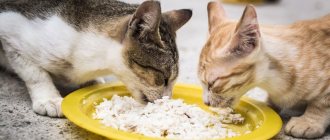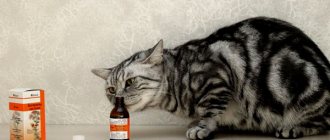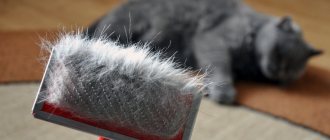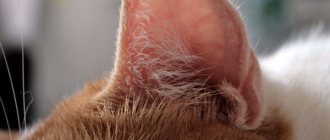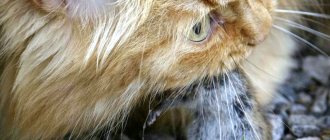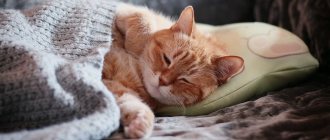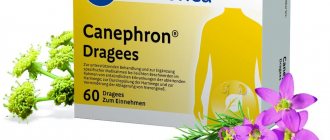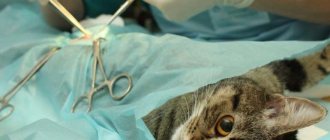Types of broad spectrum antibacterial agents
Broad-spectrum antibiotics include those that are active against more than 1 type of pathogen.
Antibiotics are effectively used to destroy bacterial, protozoan and fungal microflora in cats
According to the method of introduction into the body, antibiotics for cats are divided into means for local and general use.
Local ones include:
- ointments;
- aerosols;
- candles;
- drops;
- gels.
Common ones include:
- injection solutions;
- pills;
- capsules;
- suspensions.
By the way of influencing pathogenic microorganisms, antibacterial drugs are of 2 types:
- bactericidal (causes the death of bacteria);
- bacteriostatic (prevent the proliferation of pathogens, gradually leading to their extinction, and remove their waste products).
In some diseases, such as staphylococcal urethritis, the use of bactericidal agents is contraindicated, since the massive death of the bacterial population can block the lumen of the urethra and cause urolithiasis.
In case of sepsis, when the clock is ticking, on the contrary, only bactericidal drugs can save the life of the animal.
How to properly treat colds in cats
Like people, cats can catch a cold, and typical symptoms will arise: the cat refuses food, is depressed, and breathing becomes harsh.
There is no specific medicine to treat colds in cats. Many owners are interested in what antibiotics can be given to cats for colds? However, we should not forget that antibiotics are effective only for bacterial infections, but they are useless for viral diseases. For colds, Interferon is usually used, as well as immunoglobulins, but they are prescribed only in the first days of the disease.
Only in case of complications due to a viral disease can a veterinarian prescribe an antibiotic that is suitable individually for each pet. But if this does not happen, the cat is provided with a sufficient amount of drink per day, possibly from a syringe, good humidity in the room, and, if necessary, vitamins by injection. Usually after this the animal gets better.
Interferon is usually used for colds.
When are antibiotics needed?
As an additional remedy, antibiotics are prescribed for cancerous tumors.
The following diseases of cats are indications for taking antibiotics:
- Pneumonia.
- Respiratory infections.
- Eye inflammation.
- Intestinal infections.
- Pyelonephritis.
- Urethritis.
- Cystitis.
- Festering wounds.
- Skin infections.
- Abscesses.
- Leptospirosis.
- Pseudomonosis.
As an additional treatment, antibiotics are prescribed for cancerous tumors to prevent infection from entering the affected tissue.
Antibiotic therapy is also carried out in the period after surgical interventions to prevent infection and suppuration.
Pros and cons of antibiotics
Antibiotic therapy has its pros and cons. All these medications not only promote faster healing, but also cause harm to the caudate. You can minimize the negative consequences by selecting the most effective medication for a specific disease and correctly calculating the dose. In this case, all the advantages of this treatment method will appear:
- several doses of antibiotics will be enough to achieve the effect;
- the pet’s condition will quickly improve;
- the number of side effects is minimized;
- the antimicrobial effect will be effective even with a large number of microorganisms.
A properly selected antibiotic quickly restores the animal
However, when using antibiotic therapy, the disadvantages of this process must also be taken into account. The main negative effect of long-term treatment with this group of drugs is a decrease in the quadruped’s immunity. In addition, the following disadvantages of antibiotic therapy can be listed:
- possible addiction to the medication with a long course;
- an error in dose calculation can lead to extremely serious consequences;
- possible side effects in the form of allergic reactions and gastrointestinal disturbances;
- After treatment, it is necessary to restore the disturbed intestinal microflora.
We suggest you read: Can a cat get the flu from a person?
Side effects, contraindications
The most common side effect of antibiotics is a disruption of the intestinal microflora (dysbacteriosis). Drugs in this group have a detrimental effect not only on pathogenic, but also on beneficial microorganisms.
This side effect can be neutralized by the simultaneous intake of probiotics, which populate the intestines with the necessary microflora.
It is recommended to give them to the cat for another 2 weeks after completion of antibacterial treatment.
Be sure to read:
Duphalac ® for cats: dosage for constipation, how many times to give and instructions for use
Other adverse reactions to taking antibacterial drugs may include:
- Allergy to the active substance or auxiliary component (rash, scratching on the skin, focal hair loss).
- Edema of an immunological nature.
- Spasms and convulsive contractions of muscles.
- Breathing disorders, up to suffocation.
- Vomiting, diarrhea, stomach pain.
Antibiotics can affect the reproductive system , so at least 3 months should pass between the end of treatment and the mating of the cat. Otherwise, the offspring may be born with defects.
Antibiotics are used in the treatment of any infectious diseases.
If a cat has liver and kidney diseases, antibacterial drugs can cause their exacerbation.
In case of disturbances in the functioning of these excretory organs, taking the aminoglycoside monomycin is absolutely contraindicated, and in case of some skin diseases, bacteriostatic drugs such as chloramphenicol and syntomycin are prohibited.
The period of pregnancy and breastfeeding is also a contraindication to antibiotic therapy .
Treatment of kittens should be carried out under the supervision of a veterinarian.
Treatment of gastrointestinal pathologies
For the treatment of diseases associated with problems of the gastrointestinal tract, Forvet, a broad-spectrum antiviral drug for cats, is often prescribed. The medicine is available in the format of a sterile solution, which is used for injection. The medication has low toxicity, so it is often prescribed to weakened pets and young animals.
The main active ingredient is panavir. The component is produced from the shoots of Solanum tuberosum and is an extract of a polysaccharide complex, which contains the following components:
- rhamnose;
- xylose;
- arabinose;
- glucose;
- mannose;
- galactose;
- organic acids.
The drug also has auxiliary components: water for injection and sodium chloride.
The drug "Forvet" stimulates the synthesis of the animal's own interferon, which successfully fights microorganisms. In addition, the action of the drug is based on inhibiting the attachment of viruses to the affected cells, which leads to a decrease in their pathogenic effects and a speedy recovery.
Rules of application
Only a veterinarian should select the medicine and dosage to treat a cat. If the dose is too small, the infection will take hold in the body, even if the pet’s condition has returned to normal.
Only a veterinarian should select the medicine and dosage for treating a cat.
Exceeding the required dose can cause intoxication and even death of the animal due to the toxic effects of antibacterial drugs.
It is important not to use the medicine after its expiration date.
The drug should be purchased only from licensed pharmacies that specialize in veterinary medicines.
If the doctor prescribed the drug by injection, he must administer the first one in the clinic.
This will allow you to evaluate the reaction of the cat’s body to a foreign substance, and in case of individual intolerance, take action and prescribe another antibiotic.
It is important not to use the medicine after its expiration date
The remaining injections can be given at home according to the schedule prescribed by the veterinarian.
The least sensitive place for a puncture in a cat is the withers. The skin on it should be squeezed, insert the needle there so that it is inside and not out, and quickly inject the solution. There is no need to treat the puncture area with alcohol.
If the cat is prescribed the drug in tablet form, it is placed deeper on the tongue or crushed with food. If you need to give the tablet to a kitten, it is recommended to first divide it into parts.
It is important not to stop treatment after symptoms disappear, but to complete the full course of antibiotic therapy.
Otherwise, the pathogenic microflora will not be completely eliminated, but will go into a dormant form and become resistant to this product.
Be sure to read:
Ligfol for cats instructions for use: analogues and reviews from veterinarians
Antibiotics usually last 1-3 weeks.
The course of treatment for some dermatological infections can last 2-3 months and interrupting it is contraindicated.
Antiviral drug for cats in tablets
The drug Milbemax has gained great popularity among pet breeders. It is available in tablet format, so the owner can treat his pet on his own. The medication is intended for:
- successful cure for helminthic infestation, which was caused by cystodes and nematodes;
- prevention of worm infection.
"Melbimax" has the following composition:
- praziquantel;
- milbemycin oskim.
- microcrystalline cellulose;
- povidone;
- magnesium stearate;
- sodium carmellose;
- hypromellose, macrogol;
- talc.
In order for the animal to swallow the proposed medicine, a food additive is added to it, which gives the tablet the aroma and taste of meat.
The dosage will depend on the cat's weight:
- 2-4 kg - half a pill;
- 4-8 kg - one tablet;
- more than 8 kg - 1.5 tablets.
Milbemax is produced with different dosages of the active substance. The antiviral drug for kittens in tablets is colored pink, while red pills are intended for adults. However, the medication is prohibited from being offered to kittens whose weight is less than 500 g. When treating young cats, one pink pill is used.
Antibiotics used to treat cats
The choice of an appropriate antimicrobial drug should be based on the results of laboratory tests and the characteristics of the cat's body.
If the drug is chosen incorrectly, pathogenic microorganisms will not only not die, but will also lose sensitivity to the active substance of the antibiotic.
The following antimicrobial medications are most commonly prescribed to cats for a variety of infections.
Amoxicillin
A medication from the penicillin group, prescribed for infections of the skin, joints, genitourinary organs, bronchi and lungs.
Antibiotics usually last 1-3 weeks
After surgery, amoxicillin is given to the cat to prevent inflammation.
In case of renal failure, the dosage of the drug must be calculated with extreme caution.
Amoxicillin is also produced under other names:
- Amoxiclav (tablets, powder for the preparation of injection solution).
- Betamox (suspension for injection).
- Sinulox (tablets).
The price of the drug in tablets is from 180 rubles, solution for injections – from 230 rubles.
Azithromycin
Belongs to the category of macrolides and azalides, kills pathogenic microflora in the gastrointestinal tract, respiratory organs, urinary and reproductive systems.
The antibiotic has a prolonged effect on bacteria and fungi
The product is also effective for skin infections and rhinotracheitis (inflammation of the upper respiratory tract caused by a herpes virus).
The antibiotic has a prolonged effect on bacteria and fungi, i.e. the substance is released into the blood gradually, and the period of its effect on the body increases.
The duration of treatment is usually 5 days, less often – 1-2 weeks. Under certain circumstances, the drug is prescribed during pregnancy and lactation, but the dosage is reduced by 1.5-2 times.
The antibiotic is also represented by other drugs:
- Azikan (8% solution for injection);
- Avimecin;
- Sumamed.
The price of drugs starts from 60 rubles.
Ceftriaxone
Belongs to the cephalosporin group of 3rd generation drugs and has a prolonged effect.
The medication fights pathogens in the urinary organs and is effective against sepsis, meningitis, gangrene, abscesses and severe suppuration.
Active against gram-positive and gram-negative aerobic bacteria, many strains of salmonella and shigella. The cost of the antibiotic is from 34 rubles.
Terramycin
Available in the form of an eye ointment and a skin spray. Destroys gram-positive and gram-negative microorganisms, protozoa, mycoplasmas, proteus, chlamydia, klebsiella, rickettsia.
Be sure to read:
When to inject Fosprenil for cats - antiviral: instructions and dosage
The antibiotic in the form of a solution is administered once into the muscle, in the form of a spray - used locally for wounds and skin infections.
The average price of a spray is 350-450 rubles.
Lincomycin
Belongs to the group of lincosamides, is prescribed mainly for infections of bone and muscle tissue caused by streptococci, staphylococci, pneumococci, clostridia, anthrax pathogens, mycoplasmas, corynebacteria.
Also effective for infected wounds and abscesses. In the presence of liver and kidney diseases, the antibiotic is contraindicated. The cost of a bottle is from 400 rubles.
Drug for treatment and prevention
Antiviral drugs for cats are often used not only for treatment, but also for prevention. One of these medications is Camedon. It is indicated for animals weakened after illness to avoid recurrence of infection. Veterinarians also advise using the product after recovery from severe viral or bacterial infections, or during the treatment of complications.
The drug has two properties:
- interferon-inducing;
- immunomodulatory.
The medicine is produced in the form of a transparent sterile solution, which is used for giving injections. The active composition of the medicine is as follows:
- 10-methylenecarboxylate-9-acridone sodium salt;
- water for injections.
After injection, the solution quickly spreads through the bloodstream and produces a rapid spread of its own interferons in the cat’s body. After 20 minutes, the maximum concentration of the active component in the animal’s blood is observed.
"Kamedon" is indicated for the prevention of particularly dangerous animal diseases, and has also proven itself in the treatment of:
- all forms of plague;
- tumor processes.
The drug is prescribed to be administered once a day. To calculate the required dosage, you should adhere to the following data: per kilogram of the cat’s weight, take 0.16 ml of solution. Typically, the course of treatment lasts 7 days, but if there are obvious signs of illness or delayed therapy, treatment can be extended to 10 days. Contraindications include severe renal failure.
Does a cat need antibiotics for wounds?
For boils, inflamed wounds, and purulent skin infections, tetracycline ointment is prescribed.
When a cat has purulent wounds, it is almost always necessary to resort to antibiotics.
If there is a risk of infection, a prophylactic course of amoxicillin is administered.
When a cat has purulent wounds, it is almost always necessary to resort to antibiotics. Otherwise, the infection can spread throughout the body and cause a deadly disease - sepsis.
Such wounds are easy to identify, since pus is released from them, the hair at the site of injury is stuck together and emits a putrid odor. An increase in body temperature may also indicate that the process of suppuration has started.
catalogue of articles
Author not identifiedReposted from the forum “My affectionate and gentle beast” (Israel, no longer working)
If someone has mastered the previous information (Antibiotics in the treatment of cats (pharmacological theory), it will be easier for him to understand why and how to give antibiotics to his cat. I would like to make a reservation. I am not at all for self-medication!!! The most ideal option is when an antibiotic is prescribed by a veterinarian , that’s why he’s a doctor! Knowing that, nevertheless, many breeders, for one reason or another, often use antibiotics on their own and even have their own experience in this regard, I would like them to at least do it competently and not harm their animals Next we will discuss the main antibiotics that I have highlighted in red, and we will also discuss veterinary antibiotics such as Baytril, Convenia, Sinulox, Metronidazole/Flagyl/, which many probably know.
ok, let's start Sinulox. An excellent drug that has a very wide range of applications in veterinary medicine. It is very desirable to have one at home, of course, but it is not cheap and you can either buy it from a veterinarian or bring it from Russia. Another problem is that it cannot be stored for a very long time, and its packaging is large, 100 and 40 ml. In practice, in nurseries it is good for the treatment of inflammation in the oral cavity / stomatitis, ulcers /, after operations for the prevention of infectious complications, indispensable for intestinal infections / diarrhea, blood in the feces / in kittens and adult cats, discharge from the nose, eyes, smell of mouth It contains ampicillin, a penicillin antibiotic, also very common in veterinary medicine; clavulanic acid is added to sinulox for bacteria resistant to betalactamase. Sinulox is a yellowish-white suspension containing 35 mg/ml clavulanic acid as sodium clavulanate and 140 mg/ml amoxicillin as amoxicillin trihydrate. Sinulox for injection has a wide spectrum of bactericidal activity against microorganisms - common pathogens of cattle and small domestic animals. In vitro, sinulox is active against many types of bacteria of clinical importance: - gram-positive: Staphylococcus spp. (including beta-lactamase producing strains); Streptococcus spp.; Corynebacteria spp.; Clostridia spp.; Bacillus anthracis; Actinomyces bovis; Peptostrepcoccus spp. - gram-negative: Escherichia coli (including beta-lactamase-producing strains); Salmonella spp. (including beta-lactamase producing strains); Bordetella bronchiseptica; Campylobacter spp.; Clebsiella spp.; Proteus spp.; Pasteurella spp.; Fusobacterium necrophorum; Bacteriodes (including beta-lactamase-producing strains); Haemophylus spp.; Moraxella spp.; Actinobacillus lignieriesi. The effectiveness of Sinulox in the treatment of cattle diseases has been clinically established, including: - Infectious diseases of the respiratory system. — Infectious lesions of soft tissues (septicopyemia with joint damage and omphalophlebitis of newborns, abscesses, etc.). - Metritis. - Mastitis. In dogs and cats, Sinulox is effective for the following diseases: - Infectious diseases of the respiratory system. — Infectious diseases of the excretory system. — Infectious lesions of soft tissues (abscesses, pyodermatitis, inflammation of hair follicles and gingivitis). The recommended dosage of Sinulox for the active substance is 8.75 mg per kg of animal weight (i.e. 7.0 mg of amoxicillin and 1.75 g of clavulanic acid), which corresponds to 1 ml of Sinulox suspension per 20 kg of animal weight. The dosage of Sinulox is 12.5 mg/kg 2 times a day. Sinulox is administered subcutaneously or intramuscularly once a day, the duration of treatment is 3-5 days. Immediately after administering Synulox, massage the injection site. Vials with Sinulox should be shaken thoroughly before use. Sinulox is not intended for intravenous or intracavitary administration. Do not allow Synulox to come into contact with water (see below). CONTRAINDICATIONS AND PRECAUTIONS Sinulox, like other penicillin antibiotics, is contraindicated in rabbits, guinea pigs, hamsters, and gerbils. Sinulox should be used with great caution in other species of small herbivores. In some cases, the administration of Sinulox causes a local tissue reaction. Precautions for personnel. Penicillins and cephalosporins can cause allergic reactions in those who handle them when injected, inhaled, ingested, or come into direct contact with the skin, in some cases quite severe; Moreover, hypersensitivity to penicillins can give a cross-reaction to cephalosporins, and vice versa. Avoid contact with these drugs if you have been sensitized or if you are not advised to handle them for medical reasons. In any case, when working with these antibiotics, avoid any form of direct contact. When the first symptoms, such as skin rashes, appear, you should consult a doctor. Swelling in the face, lips, eyelids or difficulty breathing indicates a more severe injury that requires immediate medical attention. Store Synulox in a cool place. After opening a bottle of Sinulox, the contents should be used as soon as possible. Clavulanic acid is very sensitive to moisture, so when removing the contents from the vial, you should use only completely dry syringes and needles. The presence of moisture in sinulox is indicated by the appearance of dark brown droplets; This drug should not be used.
Amoxicillin 15% Long-acting antibacterial drug containing 1 ml of active ingredient 150 mg of amoxicillin in the form of trihydrate and an oily filler. Produced in the form of a sterile suspension for injection, white in 100 ml dark glass bottles, which are placed in cardboard boxes. PHARMACOLOGICAL PROPERTIES Amoxicillin is a semisynthetic antibiotic from the penicillin group. Has a wide spectrum of bactericidal action against gram-positive (Actinomyces spp., Bacillus anthracis, Clostridium spp., Corynebacterium spp., Erysipelothrix rhusiopathiae, Listeria monocytogenes, Staphylococcus spp., Streptococcus spp.) and gram-negative microorganisms (Actinobacillus spp., Bordetella bronchiseptica, E coli, Salmonella spp., Fusobacterium spp., Haemophilus spp., Moraxella spp., Pasteurella spp., Proteus mirabilis). The drug does not act on penicillinase-forming strains of microorganisms from the genera Klebsiella and Enterobacter, as well as Pseudomonas. Amoxicillin interferes with the synthesis of the bacterial cell wall, inhibiting the enzymes transpeptidase and carboxypeptidase and causing an imbalance in the osmotic balance, which leads to the death of the bacterium during the growth stage. The oily filler included in the drug gradually releases micronized amoxicillin into the blood, thereby ensuring a long-lasting effect of the antibiotic. When administered parenterally, amoxicillin 15% LA is well absorbed into the blood from the injection site and is quickly distributed in the body, reaching the highest concentration in muscle tissue, liver, kidneys, and gastrointestinal tract due to its insignificant connection with plasma proteins (17–20%). Amoxicillin penetrates to a small extent into the brain and bone fluid, except in cases where the meninges are inflamed. The maximum concentration in blood plasma is achieved 1–2 hours after administration of the drug and remains at a therapeutic level for 48 hours. Amoxicillin is practically not metabolized. It is excreted from the body mainly in urine, and to a lesser extent in milk and bile. INDICATIONS Prescribed to cattle, sheep, goats, pigs, dogs and cats for the treatment of bacterial infections of the gastrointestinal tract (including enteritis, gastroenteritis, gastroenterocolitis), respiratory diseases (including bronchitis, bronchopneumonia, rhinitis), surgical diseases (including wounds, abscesses , inflammation of the joints), diseases of the genitourinary system (metritis, endometritis, cystitis, urethritis, pyelonephritis), diseases of the skin and soft tissues (including umbilical infections), as well as complications caused by microorganisms sensitive to amoxicillin. DOSES AND METHOD OF APPLICATION Amoxicillin 15% LA is administered to animals intramuscularly or subcutaneously at a dose of 1 ml per 10 kg of animal weight (7-15 mg of active substance per 1 kg of body weight) for dogs and cats - 7 mg/kg body weight. For animals with renal failure, it is recommended to accurately adjust the dose of the drug. Before use, shake the contents of the bottle thoroughly until a homogeneous suspension is obtained. If necessary, the drug can be re-administered after 48 hours. To administer amoxicillin suspension, use only dry, sterile syringes and needles. If the administered dose of the drug exceeds 20 ml, it is recommended to administer it in several injections at different points. It is recommended to lightly massage the injection site after administering amoxicillin 15% LA. STORAGE CONDITIONS With precautions (list B). In a dry place, protected from light and out of reach of children, at a temperature of 5 to 20 ° C. Shelf life: 3 years.
Everyone's favorite Azenil Read above the group of macrolides... An excellent broad-spectrum antibiotic, very convenient to use, because it only needs to be given once a day for 3-5 days. In addition, it provides protection against chlamydia, which is very valuable in veterinary medicine. Broad-spectrum antibiotic. Azalide antibiotic, a representative of a new subgroup of macrolide antibiotics. When high concentrations are created at the site of inflammation, it has a bactericidal effect. Gram-positive cocci are sensitive to Azithromycin: Streptococcus pneumoniae, St. pyogenes, St. agalactiae, group CF and G streptococci, Staphylococcus aureus, St. viridans; gram-negative bacteria: Haemophilus influenzae, Moraxella catarrhalis, Bordetella pertussis, B. parapertussis, Legionella pneumophila, H. ducrei, Campylobacter jejuni, Neisseria gonorrhoeae and Gardnerella vaginalis; some anaerobic microorganisms: Bacteroides bivius, Clostridium perfringens, Peptostreptococcus spp; as well as Chlamydia trachomatis, Mycoplasma pneumoniae, Ureaplasma urealyticum, Treponema pallidum, Borrelia burgdoferi. Azithromycin is inactive against gram-positive bacteria resistant to erythromycin. has a very interesting mechanism of action/pharmacokinetics/absorption. Azithromycin is rapidly absorbed from the gastrointestinal tract, due to its stability in an acidic environment and lipophilicity. After oral administration of 500 mg of Azithromycin, the maximum concentration of azithromycin in the blood plasma is reached after 2.5–2.96 hours and is 0.4 mg/l. Bioavailability is 37%. Distribution. Azithromycin penetrates well into the respiratory tract, organs and tissues of the urogenital tract (in particular, the prostate gland), skin and soft tissues. The high concentration in tissues (10-50 times higher than in plasma) and the long half-life are due to the low binding of azithromycin to plasma proteins, as well as its ability to penetrate eukaryotic cells and concentrate in the low pH environment surrounding lysosomes. This, in turn, determines the large apparent volume of distribution (31.1 l/kg) and high plasma clearance. The ability of azithromycin to accumulate predominantly in lysosomes is especially important for the elimination of intracellular pathogens. It has been proven that phagocytes deliver azithromycin to sites of infection, where it is released during the process of phagocytosis. The concentration of azithromycin in foci of infection is significantly higher than in healthy tissues (on average by 24-34%) and correlates with the degree of inflammatory edema. Despite its high concentration in phagocytes, azithromycin does not have a significant effect on their function. Azithromycin remains in bactericidal concentrations at the site of inflammation for 5-7 days after taking the last dose, which made it possible to develop short (3-day and 5-day) courses of treatment. Excretion. The elimination of azithromycin from blood plasma occurs in 2 stages: the half-life is 14-20 hours in the range from 8 to 24 hours after taking the drug and 41 hours in the range from 24 to 72 hours, which allows the drug to be used once a day. Indications for use: Infectious diseases caused by pathogens sensitive to the drug: infections of the upper respiratory tract and ENT organs - tonsillitis, sinusitis (inflammation of the paranasal sinuses), tonsillitis (inflammation of the tonsils), otitis media (inflammation of the middle ear cavity) ; scarlet fever; infections of the lower respiratory tract - bacterial and atypical pneumonia (pneumonia), bronchitis (inflammation of the bronchi); infections of the skin and soft tissues - erysipelas, impetigo (superficial pustular skin lesions with the formation of purulent crusts), secondary infected dermatoses (skin diseases); genitourinary tract infections - gonorrheal and non-gonorrheal urethritis (inflammation of the urethra) and/or cervicitis (inflammation of the cervix); Lyme disease (borreliosis is an infectious disease caused by the Borrelia spirochete). Ideal for kittens with nasal and eye discharge, diarrhea with mucus and blood, when other antibiotics do not help. It is important that it covers chlamydia and mycoplasma, and since infections are often mixed, it gives a very quick effect after just one or two doses. In Israel it is sold in syrup and tablets. The syrup is prepared by adding 9 ml of water to the powder, resulting in 15 ml of ready-to-use syrup. The syrup is viscous and thick, after dilution it can be used within 10 days, you should not put it in the refrigerator, it freezes and becomes even thicker, so that you cannot put it into a syringe. Dose: 10 mg per kg of weight. The concentration of the syrup is 40 mg in 1 ml, that is, 1 ml is a dose for a cat weighing 4 kg. For kittens, it is calculated by proportion. If a kitten weighs 1 kg, then it needs a quarter ml - 0.25 ml. If it is 500 grams, then 0.125 ml. Such doses can be taken with a Mantoux syringe. It is given by mouth 1 time per day at one time for a course of 3 to 5 days.
Small type according to Azenil. When diluting a whole bottle, most of it is eventually thrown away, since due to its small weight, you don’t need much for a course of treatment, and since the medicine is not freely available for everyone, it makes sense, having, for example, one bottle, to use it with maximum benefit . What can be done. Take a 10 ml dry syringe, remove the plunger, close the tip with your finger and pour powder from the bottle into it somewhere up to the 7 ml mark, this is a third of the total amount. It must be diluted accordingly in 3 ml of water / if you dilute the entire bottle by 9 and get 15 ml of ready-made syrup / You will get 5 ml of ready-made syrup and the rest of the powder will remain for 2 more such times. Dry powder in its original bottle can be stored for a long time.
Flagyl / Metronidazole / Broad-spectrum antibiotic. The main use in veterinary medicine is protozoa/ amoebas, giardia, etc./ and anaerobes, therefore good for the treatment of intestinal infections/ diarrhea in kittens/ and gingivitis. In combination with other antibiotics also for endometritis / pyometra / Dose for cats 10-25 mg per kg of body weight 2 times a day / average 12 mg per kg / Course of treatment 5-7 days Antiprotozoal and antimicrobial drug, a derivative of 5-nitroimidazole. The mechanism of action is the biochemical reduction of the 5-nitro group of metronidazole by intracellular transport proteins of anaerobic microorganisms and protozoa. The reduced 5-nitro group of metronidazole interacts with the DNA of microbial cells, inhibiting the synthesis of their nucleic acids, which leads to the death of bacteria. Active against Trichomonas vaginalis, Entamoeba histolytica, Gardnerella vaginalis, Giardia intestinalis, Lamblia spp., as well as obligate anaerobes Bacteroides spp. (including Bacteroides fragilis, Bacteroides distasonis, Bacteroides ovatus, Bacteroides thetaiotaomicron, Bacteroides vulgatus), Fusobacterium spp., Veillonella spp., Prevotella (Prevotella bivia, Prevotella buccae, Prevotella disiens) and some gram-positive microorganisms (Eubacter spp., Clostridium spp., Peptococcus spp., Peptostreptococcus spp.). The MIC for these strains is 0.125-6.25 μg/ml. In combination with amoxicillin, it is active against Helicobacter pylori (amoxicillin suppresses the development of resistance to metronidazole). Aerobic microorganisms and facultative anaerobes are insensitive to metronidazole, but in the presence of mixed flora (aerobes and anaerobes), metronidazole acts synergistically with antibiotics that are effective against common aerobes. Increases the sensitivity of tumors to radiation, causes disulfiram-like reactions, and stimulates reparative processes. Indications for use: Protozoal infections: extraintestinal amebiasis, including amoebic liver abscess, intestinal amebiasis (amoebic dysentery), trichomoniasis, giardiasis, balantidiasis, giardiasis, cutaneous leishmaniasis, trichomonas vaginitis, trichomonas urethritis. Infections caused by Bacteroides spp. (including Bacteroides fragilis, Bacteroides distasonis, Bacteroides ovatus, Bacteroides thetaiotaomicron, Bacteroides vulgatus): infections of bones and joints, infections of the central nervous system, incl. meningitis, brain abscess, bacterial endocarditis, pneumonia, empyema and lung abscess, sepsis. Infections caused by Clostridium spp., Peptococcus and Peptostreptococcus species: abdominal infections (peritonitis, liver abscess), pelvic infections (endometritis, fallopian tube and ovarian abscess, vaginal vault infections). Pseudomembranous colitis (associated with antibiotic use). Gastritis or duodenal ulcer associated with Helicobacter pylori. Prevention of postoperative complications (especially interventions on the colon, perirectal area, appendectomy, gynecological operations). Radiation therapy for patients with tumors - as a radiosensitizing drug in cases where tumor resistance is due to hypoxia in tumor cells. Not recommended for pregnant cats or those suffering from liver failure. There is no veterinary FLAGIL, so human one is used. Available in tablets and syrup. It tastes disgusting, cats and kittens really don’t like it, they spit and drool. It is advisable to give by spraying immediately deep behind the root of the tongue.
A few thoughts about diarrhea in kittens. There is probably no breeder whose kittens have not been vilified. Why do they vilify... Most often, until 3-4 weeks, healthy kittens do not vilify, they feed on their mother's milk, do not go to the toilet, and do not drink water from the bowl. It all usually starts as soon as the kittens are provided with a toilet, food and water. As for the toilet... The most ideal option is for the kittens not to use the toilet that the mother cat goes to, I’m not even talking about other cats at all. Well, or so that the mother cat does not use the toilet that the kittens go to. Why? Yes, because all our adult animals are carriers of all kinds of bacteria and viruses, to which they have developed antibodies over the years and which do not harm them. For small kittens with an imperfect immune system, these pathogens can be dangerous. It is enough for kittens to tinker in the secretions of an adult cat and they are already diarrhea. The same thing happens with drinking from a common bowl of water... kittens stick their paws into the water after using the toilet, and then drink it, that's the route of transmission. How to prevent this is the breeder's imagination... You can, for example, place the cat's toilet higher up or in a different place, and provide the kitten's toilet with a door with a small hole so that the cat cannot go there... Another reason for diarrhea in kittens is introduction complementary foods... Boiled chicken, rice pates, cottage cheese and seemingly the most harmless food can cause severe irritation of the intestines when they get there for the first time and the kitten begins to have colitis...diarrhea, often with blood, kittens scream, strain, the stool becomes with an unpleasant sour smell and mucus... the entire flora has already been disrupted and the bacterial flora has begun to celebrate. If kittens are left untreated, they may die from dehydration. For a kitten aged 3-5 weeks, it is enough to vomit 3-4 times and diarrhea a couple of times to become severely dehydrated / the kitten is restless, rushes about, pokes at the walls, screams, throws back its head / - all these are signs of acidosis due to dehydration. It is urgent to start injecting saline or ringer lactate under the withers every 2 hours, every other time add 5% glucose, Duphalight and start an antibiotic. What's the best place to start... You shouldn't start with Azenil. It is quite enough to treat kittens with a combination of Moxipen and Flagyl for a week. Moxipen - children's syrup at the rate of 20 mg per kg of weight, Flagyl 12 mg per kg of weight, both 2 times a day. If the stool is green, foamy, and the kitten’s general condition is serious, then Moxipen and Azenil. Moxipen 2 times a day, Azenil 1 time a day. At the same time, it is worth taking a stool test for parasites; sometimes kittens can have coxdia and other parasites. If this is some kind of banal infection, then after 2-3 days there will be a noticeable improvement. You can also inject the broad-spectrum antibiotic Rocephin, which we haven’t talked about yet. Of course, I understand that not everyone can afford frequent visits to veterinarians, given the high prices, so many have learned how to somehow cope with such diarrhea... but diarrhea is different from diarrhea... if you feel that there is no improvement, that the general condition is worsening , then you need to see a doctor.
Let's talk about Baytril A broad-spectrum antimicrobial drug for the treatment of infectious diseases. Available in different concentrations; Baytril 2.5% is preferable for cats. Effective against gram-positive and gram-negative bacteria (Staphylococcus aureus. Streptococcus ssp, Clostridi'um perfrin -gens, E. coli, Salmonella ssp., Proteus sp„ Pasteurella multocida, Pasteurella haemolytica, etc.) and mycoplasmas It is quickly absorbed into the blood and penetrates well into all tissues and cells of the body. Bactericidal concentration in organs is achieved within an hour after administration and persists for 24 hours. In the affected tissue, the concentration is higher than in healthy tissue. Does not have an immunosuppressive effect, but, on the contrary, accumulates in macrophages and neutrophils, acts on intracellular and extracellular microorganisms. Does not cause an allergic reaction. Non-toxic, does not have a mutagenic or teratogenic effect, does not cause reproductive dysfunction. It is produced in mainly with urine, does not cause a nephrotoxic effect. The presence of pus and an acidic environment does not interfere with the action of the drug. The bactericidal effect of Baytril is associated with a disruption of the process of bacterial DNA replication by affecting DNA gyrase, which causes negative supercoiling, turning DNA into a covalent closed structure. Enrofloxacin, which is part of Baytril, belongs to the group of fluoroquinolones and has a wide spectrum of antimicrobial action, is active against gram-positive and gram-negative microorganisms, including Escherichia, Salmonella, Pasteurella, Staphylococcus, Pseudomonas, Bordetella, Campylobacter, Corynebacterium, Proteus and Mycoplasma . Enrofloxacin is quickly absorbed into the blood and penetrates all organs and tissues of the body. The maximum concentration of the drug in the blood is reached after 1.5-2 hours and remains for 6 hours, and the therapeutic concentration for 24 hours. The drug is excreted mainly unchanged in the urine and bile. Indications for use: * Diseases of the respiratory system, gastrointestinal tract, genitourinary system, skin, septicemia, osteomyelitis caused by gram-positive and gram-negative bacteria (staphylococcus aureus, streptococcus spp., Clostridium perfringens, E. Coli, salmonella spp., Proteus sp. , Pasteurella multocida, Pasteurella haemolytica, etc.) and mycoplasmas. * As a prophylactic agent during operations and during the rehabilitation period after operations Dosage and method of administration: Recommended dose 5 mg per 1 kg of weight: Baytril 2.5% - 0.2 ml/kg, Baytril 5% - 0.1 ml/kg. The drug is administered subcutaneously, intramuscularly once a day. The course of treatment is on average 5 days. The shelf life of the drug, subject to storage conditions, is 3 years from the date of manufacture, after opening the bottle - 28 days. Not recommended for kittens under 6-8 weeks of age!
Indications for use and recommendations: • Diseases of the respiratory system • Diseases of the gastrointestinal tract • Diseases of the genitourinary system • Skin diseases • Septicemia • Osteomyelitis, as a prophylactic agent before surgery and during the rehabilitation period after surgery “Baytril®” - treatment of respiratory diseases • Accumulates in bronchial secretions and macrophages • Does not interfere with the work of the ciliated epithelium • Especially recommended for chronic diseases and sinusitis • Course of use averages 5 days “Baytril®” - treatment of skin diseases • Effective in an acidic environment, unlike most antibiotics • Recommended for treatment ulcers, abscesses, fistulas, wounds. The presence of pus does not interfere with the action of the drug • Course on average 7-10 days • Treatment of otitis “Baytril®” - treatment of osteomyelitis • Effective in the treatment of osteomyelitis • Course 5-15 days • Recommended for prophylactic purposes before any operations and during the rehabilitation period after surgery “ Baytril®" - treatment of diseases of the gastrointestinal tract • Does not have a harmful effect on the normal microflora of the gastrointestinal tract • The course of treatment is on average 5 days, for acute and chronic diarrhea - up to 10 days • Treatment of diseases of the oral cavity. High concentration in saliva, which is convenient in the treatment of gingivitis, periodontal disease, stomatitis, dental diseases together with metronidazole “Baytril®” - treatment of diseases of the genitourinary system • A high and prolonged concentration is achieved in urine, in prostate secretions • No nephrotoxic effect • Course of treatment of at least 7 days
So we reached Rocephin. If you're looking for an antibiotic that crosses the BBB, you can't do better than this. Active ingredient ›› Ceftriaxone* (Ceftriaxone*) Latin name Rocephin Today the most popular antibiotic in pediatrics. Very wide spectrum of action. Convenient to use, as it is done once a day. It has a bactericidal effect on many gram-negative and gram-positive bacteria. Highly susceptible species are: Proteus mirabilis, Haemophilus influenzae, Neisseria gonorrhoeae, Neisseria meningitidis, Escherichia coli, Salmonella spp., Shigella spp., Klebsiella spp., Klebsiella pneumoniae, Enterobacter, indole-positive Proteus, Streptococcus viridans, Streptococcus pneumoniae. Moderately sensitive strains are: Serratia marcescens, Pseudomonas aeruginosa, Staphylococcus aureus, Listeria monocytogenes, Bacteroides fragilis, Clostridium spp., Chlamydia trachomatis. Weakly sensitive strains are: Pseudomonas spp. (except P.aeruginosa), Streptococcus faecalis, Mycoplasma hominis and pathogenic fungi. It is resistant to the action of most beta-lactamases and therefore acts on strains with acquired tolerance to other cephalosporins. Indications Infections of the urinary, respiratory and biliary tract, gastrointestinal tract, bones and joints, skin and soft tissues, ENT organs, reproductive system; peritonitis, sepsis, meningitis, gonorrhea. In cats, the usual dose is 25 to 50 mg per kg every 12 hours intramuscularly, intravenously or subcutaneously. This is what it says in veterinary reference books. My personal experience with this antibiotic is 20 mg per kg once a day. There are bottles of 250, 500 and 1000 mg powder, which is diluted 500 mg in 5 ml of water for injection or saline, 1 gram in 10 ml. This gives a concentration of 100 mg in 1 ml of the finished solution. For an ordinary adult cat 5 kg, 1 ml is enough, you can inject it under the withers, it can be mixed with liquid/infusion/ Kittens are calculated by weight kitten 1 kg 0.2 ml kitten 500 grams-0.1 ml If you follow veterinary reference books, you can inject more, I was always quite satisfied with the results from the minimum dose. The course of treatment can be 3-5 days, sometimes 1 injection is enough. There is no point in diluting Rocephin with Loidocaine and injecting it into the muscle. It is well absorbed from under the withers. The diluted bottle can be stored in the refrigerator for up to 10 days; it will darken a little, but this is normal.
Another interesting anibiotic /veterinary/ from the cephalosporin series is Convenia. Due to its long-lasting action, it is ideal for treating outdoor cats, shelter cats, etc., where one injection can provide antibiotic coverage for up to 2 weeks! INSTRUCTIONS for the use of the drug Convenia for the treatment of bacterial infections in dogs and cats (manufacturer organization “Pfizer Italia Srl” / “Pfizer Italy Srl”, Italy) I. GENERAL INFORMATION 1. Convenia is an antibacterial drug intended for the treatment bacterial infections of the skin, soft tissues and urinary tract in dogs and cats. 2. Convenia is an antibacterial drug in the form of a lyophilized powder containing as an active ingredient 825 mg of the antibiotic cefovecin (in the form of sodium salt) and an injection solvent containing 13 mg/ml benzyl alcohol and 10.8 ml water for injection. 3. In appearance, Convenia is a white to yellow powder. Solvent for injection is a clear, colorless liquid. 4. Convenia is produced in the form of a lyophilized powder, packaged in 20 ml glass bottles, and a solvent for injection, packaged in 15 ml glass bottles, sealed with rubber stoppers with aluminum caps. A bottle of powder and a bottle of solvent are packaged in a cardboard box. Each bottle and box is labeled in Russian indicating the name of the medicinal product, the name of the manufacturing organization and its address, the name and content of the active substance, purpose, storage conditions, batch number, date of manufacture and expiration date, the inscriptions “For animals” and “Sterile” " Store Convenia with caution (list B) in a place protected from light at a temperature of 2ºС to 8 °С. The shelf life of the undiluted drug when stored in original packaging is 2 years. The shelf life of the drug after dilution is 28 days. The diluted drug is stored in a place protected from light in the original packaging at a temperature from 2ºС to 8 °С. Do not freeze. When storing a diluted drug, the solution may darken, but the antibacterial activity does not decrease. It is prohibited to use the medicine after the expiration date. II. PHARMACOLOGICAL PROPERTIES 5. Convenia is a bactericidal antibiotic of the third generation cephalosporin group, which has a wide spectrum of bactericidal activity against most gram-positive and gram-negative microorganisms. The antibiotic exhibits high activity against Staphylococcus intermedius and Pasteurella multocida, usually isolated from skin infections of dogs and cats, Prevotella oralis, Bacteroides spp. and Fusobacterium., isolated from abscesses in cats. The drug is active against Escherichia coli isolated from urinary tract infections in dogs and cats. 6. The antibacterial effect of the drug Convenia is due to inhibition of bacterial cell wall synthesis. The drug has a prolonged effect; the therapeutic effect of the drug in dogs and cats lasts at least 14 days. III. ORDER OF APPLICATION OF THE DRUG 7. Convenia is used in dogs and cats for the treatment of skin and soft tissue infections (abscesses, pyoderma) caused by Staphylococcus intermedius, β-hemolytic Streptococci, Escherichia coli and/or Pasteurella multocida, urinary tract infections caused by Escherichia coli and/or Proteus spp. 8. Convenia is administered subcutaneously to dogs and cats at a dose of 8 mg/kg of animal weight, which is equivalent to 1 ml of the drug per 10 kg of live weight. The drug is administered once, if necessary, a second injection is carried out 14 days after the first injection, but no more than three injections per course of treatment. To prepare a solution for injection, add the contents of a bottle of solvent (10 ml) to a bottle containing lyophilized powder and shake until the powder is completely dissolved. 9. When Convenia is prescribed in accordance with the instructions, no side effects or complications are noted. In case of individual sensitivity of animals to betalactam antibiotics, allergic reactions may develop. In this case, the drug is discontinued and antihistamines are prescribed. 10. It is not recommended to use the drug together with furosemide, ketoconazole and non-steroidal anti-inflammatory drugs, as well as other drugs that have a high level of protein binding due to the possibility of side effects. 11. It is not recommended to use the drug in animals with hypersensitivity to antibiotics of the penicillin and cephalosporin groups, pregnant animals and animals during the mating period. It is prohibited to use the drug in dogs and cats under 8 weeks of age. IV. PERSONAL PREVENTION MEASURES 12. When using the Convention, you should follow the general rules of personal hygiene and safety precautions provided for when working with medicines. After work, wash your hands thoroughly with warm water and soap. It is prohibited to consume food or water while working. 13. Keep the Convention out of the reach of children. The instructions were developed by Pfizer (USA). Manufacturer: Pfizer Italia Srl, Borgo san Michele (LT) ss 156km50 – Latina, Italy.
Author not identified
Reposted from the forum “My affectionate and gentle beast” (Israel, no longer working)
Can a cat treat a wound with iodine?
It is contraindicated to treat a purulent wound with iodine and brilliant green. If it does not fester, you can lubricate its edges with iodine without getting deep into the damage.
Before applying the medicine, it is necessary to clean the damaged area from hair and dirt. Dried pus can be softened using hydrogen peroxide (up to 3%), and the fur must be carefully cut off with scissors.
suitable for cleaning the injured surface .
How to administer an antibiotic intramuscularly?
You need to inject medications using a new syringe each time. The cat needs to be secured with the elbow of your free hand so that it does not jerk when the medicine is administered - some antibiotics are very painful. There is no need to lubricate the injection site with alcohol.
The drug in the syringe must be warmed by hand to at least room temperature. There is no need to inject the solution directly from the refrigerator. The selection of needles is carried out in accordance with the volume and viscosity of the medication. If the medicine is administered no more than one cube and the solution is of aqueous consistency, you can take an insulin syringe. If the antibiotic is of the oily type, you will need a regular syringe with a medium needle.
The injection is placed in the thigh so that there is at least 1 cm of needle inside. If a small amount of medication is administered, it must be administered quickly. If the solution is large, it should be administered slowly. After the injection, you should not hold the animal and calm it down. The cat will immediately run away and cope with the stress itself. If after the injection the cat begins to tuck its paw or limp a little, it’s okay; this reaction will go away within one to two days.


